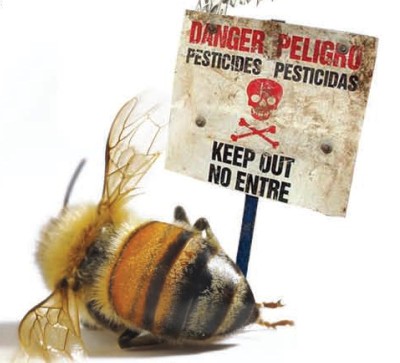For some time, modern science’s craving for control over nature could be viewed as a harmless pursuit. Those days are long gone, though. With the polar icecaps melting, the oceans flooded with garbage and radioactive waste, and widespread illness on the rise, it’s now clear that our modern industrial culture is killing the planet, and it’s taking us down with it.
A prominent example of the debilitating effect that humans are having upon the environment is bee colony collapse, which has experts around the world extremely worried.
In case you’re unaware of how extensive the problem is, here’s where we’re at: a report just released in late February 2016 by the United Nations Intergovernmental Science-Policy Platform on Biodiversity and Ecosystem Services warned that we’re putting 16% of all vertebrae pollinators (including bees) at significant risk of extinction. [1]
If this extinction event occurs, the report states, an astounding 75% of the world’s food supply would be at risk. It’s estimated that bees and other pollinators are directly responsible for one out of every three bites of available food!
So what’s killing the bees?
For years, researchers have been frantically trying to determine what’s causing bee colony collapse. There are many theories, and while the problem is almost certainly multi-pronged, one conclusively demonstrated cause is the widespread use of toxic agricultural pesticides.
A recent high-tech study that was published in the Journal of Chromatography A revealed that the vast majority of the dead bees in collapsed colonies contain a plethora of pesticide residues.[2]
Here’s why pesticides are a major problem for bees: in the same way that pesticides can disrupt human immune and endocrine function, they can also weaken bees’ defense systems.
This leaves bees vulnerable to pathogens, which can be absolutely detrimental to pollinators that operate in accordance with a hive mind (because individual weaknesses in the hive progressively weaken the entire system until it collapses).
The study mentioned above, which focused on samples taken in Poland, found up to thirteen different pesticides in a single bee specimen, and 57 total pesticides.
Researchers even found one pesticide called clothianidin, which is banned in Europe because of the proven danger it poses to bees. It’s no wonder, then, that colonies are collapsing!
These results demonstrate that even the E.U., despite its banning of many blatantly toxic pesticides (such as glyphosate-containing RoundUp), is not immune to the issues affecting pollinators. In fact, bee colony collapse in Europe has risen above 30%—not far behind the United States, where a worrying 40% of bee colonies are experiencing collapse.
While studies on the toxicological profile of collapsed bee colonies in the United States are still forthcoming, past research on general pesticide residues have discovered that contamination is much worse in the United States. In 2013, the Department of Agriculture found that our food supply is contaminated with at least 165 different pesticides.[3]
Thus, it’s safe to assume that American bee colony contamination is even more serious and widespread than in Europe. Nevertheless, the U.S. has yet to impose bans on bee-killing pesticides like clothianidin, despite incriminating evidence released the EPA.
How we can save the bees
The solution to bee colony collapse is simple but radical: we must accept that our societal dependence upon industrial agriculture is unsustainable, that this industry’s practices are poisoning our planet, and that we must change the way that we produce our food supply.
We can only hope that our current pollinator crisis is a wake-up call—that awareness about the issue can generate the momentum necessary to ban the use the toxic pesticides and reform the agricultural industry.
You can help support this transition—in fact, change will never come without the support of each of us as individuals. Vote with your wallet by supporting local, organic, pesticide-free farms instead of poison-wielding mega-farms.
Support new, bee-friendly agricultural practices, such as entomovectoring, which employs bees to deliver a tiny amount of natural pesticide directly to crops (rather than drenching them with huge amounts of toxic chemical pesticides).
Encourage change on a legislative level by supporting activism campaigns, like this one run by Takepart.com and all the work of the Pesticide Action Network.
Europe is picking up the pace with which they ban pesticides specifically because they’re harmful to bees, but the U.S. is still lagging far behind on its bee-safe policy…so take a moment to get involved in this movement!
And if you’re feeling really ambitious, you can even learn to keep your own backyard beehive. Doing so is not only a great way to support local pollination and the continuation of bee species—it’s also an incredible way to connect with nature and massively improve the quality of your garden.
Bees and other pollinators literally make our food supply possible. Isn’t it time we returned the favor by helping to protect them?
References
[1] http://www.ipbes.net/article/press-release-pollinators-vital-our-food-supply-under-threat
[2] http://www.sciencedirect.com/science/article/pii/S0021967316300012






